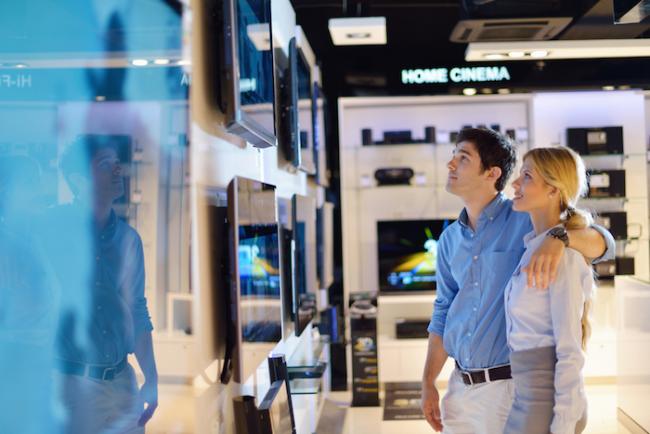Reinventing Retail: The Role of In-Store Technology (Part 2)

In part one of "Reinventing Retail: The Impact of Mobile Shopping (Part 1)," we looked at the technologies that are shaking up the shopping status quo and how some retailers are reacting. In part two, let's discuss how businesses can embrace this future of physical-meets-digital retail by bringing their own technologies into their brick-and-mortar stores.
Three thousand professionals working for the world's' largest brands and retailers joined together in Las Vegas in May at ShopTalk 2016. The retail convention provided attendees with some amazing insights into current industry trends, and many leaders took to the stage to explain how they're developing and practicing cutting-edge strategies based on the state of the sector.
Create experiences that blur the line between traditional shopping and ecommerce.
One key takeaway from the event was a common theme shared by a majority of the presenters: It's time to seamlessly blend physical with digital and create shopping experiences that blurs the line between traditional commerce and ecommerce.
The consensus at ShopTalk 2016 was that in order to bridge the digital to physical gap and provide a truly memorable customer experience, retailers must leverage in-store technologies. In other words, ecommerce won't disintegrate traditional retail - it will become a part of it.
"The future doesn't belong to Internet-only companies," said Gerald Storch, CEO of Hudson's Bay Corp., according to the Associated Press. "It belongs to customer-facing brands that meet the needs of the customer, however she wants it, whenever she wants it. All companies will be Internet companies, or they won't be companies at all."
So let's take a look at some ways that retailers can use in-store technology to improve their customers' overall shopping experience.
Support mobile payment technology
Deploying a point-of-sale system that can accept mobile payments might seem like a small step forward, but it represents a giant leap in customer experience. According to a MindTree survey, 33 percent of consumers want to shop in stores "faster," while Retail Info Systems News reported that 55 percent of retailers said their top POS goal is to move customers through checkouts more quickly.
And EMV chip-based payment cards are anything but fast. Paying with EMV takes a long time, and when lines get backed up, customers start to have a negative in-store experience.

Arm in-store associates with mobile devices
Another way to speed up shopping experiences is to give employees mobile devices, which is how Apple Stores are able to quickly and easily check out their customers as they're in the moment of truth. RIS explained that this is a great way to optimize in-store experiences and "facilitate more meaningful interactions between associates and shoppers." Additionally, associates with mobile devices can provide consumers with product information and recommendations, and it never hurts to make a smarter purchase decision.
Develop an app with a focus on optimizing in-store experiences
Retailers don't necessarily need to arm in-store employees to help create more informative and engaging shopping experiences. Instead, businesses can develop a mobile app that connects customers directly to customer service representatives, either via a messaging capability or video conference. That way, if they have a question about a product, they can just ask a representative without leaving the aisle.
Furthermore, the MindTree survey found that 11 percent of shoppers want to use their mobile devices - or kiosks - to "quickly and efficiently" discover products in stores. By adding a map to a retail app, businesses can satiate that need.
Create an endless aisle
There are a couple of ways to provide customers with an endless aisle. The first method is to allow associates to order products for shoppers with a tablet or smartphone. Alternatively, retailers can put kiosks at the end of the aisle which will allow consumers to quickly order an item if they can't find it on a shelf. The latter is getting pretty popular, considering data from RIS that indicated 16 percent of retailers already have in-store kiosks or similar digital devices, and 51 percent will have these technologies in place within the next two years.
The IoT will be particularly useful for optimizing the shopping experience.

Implement the Internet of Things
The Internet of Things - or IoT - is expected to impact the retail industry in numerous ways, from the supply chain to product returns. But the IoT will be particularly useful if retailers use these technologies at brick-and-mortar locations to optimize the shopping experience.
For example, Business Insider highlighted the value of "smart shelves" - shelves with embedded sensors that are capable of pinging employees when inventory declines past a certain threshold. Better yet, if some businesses go all-in on the IoT, smart shelves can immediately trigger the delivery of new shipments. The source said that this in-store retail technology can even identity thefts. But that's not all. With smart shelves, retailers can change prices on the fly.
Get extra innovative
Some retailers and tech companies are getting really inventive when trying to bring technology into physical stores. Adobe is working on smart shopping bags which will start calculating costs and scanning products before customers are done browsing, as reported by Tech.Co. That innovator is also working on a kiosk that will allow for more personalization thanks to a Microsoft Kinect camera that identifies shoppers, Fashionista reported. Then there's Westfield, a company that owns malls around the country. At ShopTalk 2016, Westfield co-CEO Steven Lowy said that it will use big data and analytics, web applications, interactive storefronts and more to optimize shopping experiences, Retail Dive said.
There's so much potential for in-store technologies, and this list is not comprehensive, to say the least. But this should help retailers start thinking more creatively when it comes to improving their physical shopping experiences.
References:
http://bigstory.ap.org/article/996a3dfe32e449749a4c9bdedcc2e5cd/ponderin...
http://www.mindtree.com/phygitalshopper/us/pdf/mindtree-us-detailed-repo...
http://risnews.edgl.com/User-Registration/Downloads?ubctid=2&GUID=7305bc...
http://risnews.edgl.com/User-Registration/Downloads?GUID=103bea40-f55c-4...
http://www.businessinsider.com/sc/technology-changing-the-in-store-retai... https://tech.co/adobe-summit-adobe-smart-bag-2016-04 http://fashionista.com/2016/03/adobe-personalized-shopping-kinect

